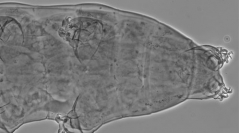

 European Journal of Taxonomy
930 (79) - Pages 79-123
European Journal of Taxonomy
930 (79) - Pages 79-123In this study, I describe two new species of Macrobiotus based on morphological data collected through light and scanning electron microscopy. Both species are accompanied by DNA sequences from four commonly used molecular markers (18S rDNA, 28S rDNA, ITS-2, and COI). Macrobiotus ovovittatus sp. nov. was discovered in Greenland and can be distinguished from similar taxa of Macrobiotus by its continuous, solid, and clearly wrinkled egg surface, adorned with sparse, very small and irregularly spaced pores. Additionally, the terminal discs of egg processes are covered in multiple light-refracting dots, resembling crocheted napkins. Macrobiotus mileri sp. nov. was found in Israel and is characterized by unique pore arrangements in its body cuticle, expressed in two distinct animal forms: (i) forma porata with large pores arranged in five distinct patches and (ii) forma aporata with single, almost undetectable pores. It also features weakly defined convex terminal discs with smooth edges. Furthermore, the phylogenetic analyses conducted in this study offer the most updated phylogeny of superclade I within the family Macrobiotidae. This facilitates additional discussion concerning the interrelationships among species within the genus Macrobiotus and the circumscription of species groups within it.
Egg ornamentation, morphology, Macrobiotus polonicus-persimilis species complex, new species, water bears